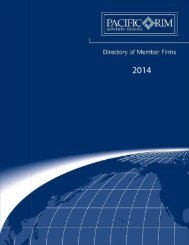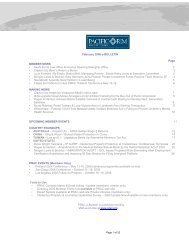A Guide to the Law of Securitisation in Australia - Clayton Utz
A Guide to the Law of Securitisation in Australia - Clayton Utz
A Guide to the Law of Securitisation in Australia - Clayton Utz
- No tags were found...
You also want an ePaper? Increase the reach of your titles
YUMPU automatically turns print PDFs into web optimized ePapers that Google loves.
60<strong>in</strong>demnity existed) and had no hand <strong>in</strong> subsequent events whichrendered <strong>the</strong> trustee <strong>in</strong>capable <strong>of</strong> meet<strong>in</strong>g <strong>the</strong> liability, isnever<strong>the</strong>less held liable for <strong>the</strong> debt.In all trust securitisations, as a general rule, <strong>the</strong> trust deed willprovide that <strong>the</strong> trustee will only be liable <strong>to</strong> <strong>the</strong> extent <strong>of</strong> <strong>the</strong>assets available <strong>to</strong> meet <strong>the</strong> relevant liability. Such a limitationensures that section 197 will not apply <strong>to</strong> <strong>the</strong> transaction andavoids <strong>the</strong> rule that <strong>the</strong> direc<strong>to</strong>rs will be liable if <strong>the</strong>securitisation trust becomes <strong>in</strong>solvent.That be<strong>in</strong>g <strong>the</strong> case, if <strong>the</strong> trust is liable <strong>to</strong> third parties who arenot bound by <strong>the</strong> limitation <strong>of</strong> liability (for example, <strong>the</strong>Commissioner <strong>of</strong> Taxation under an outstand<strong>in</strong>g tax liability) <strong>the</strong>nsection 197 may apply <strong>to</strong> <strong>the</strong> liability and cause <strong>the</strong> direc<strong>to</strong>rs <strong>to</strong>be bound <strong>to</strong> discharge it if <strong>the</strong> trust becomes <strong>in</strong>solvent.Trustee only personally liable for fraud, negligence or wilful defaultTypically, a trustee’s limitation <strong>of</strong> liability clause also providesthat <strong>the</strong> trustee will only be personally liable for any losssuffered by an <strong>in</strong>ves<strong>to</strong>r as a result <strong>of</strong> <strong>the</strong> trustee’s fraud,negligence or wilful default (or similar). This is a standardrequirement <strong>of</strong> <strong>the</strong> trustee companies, however, it has <strong>in</strong>terest<strong>in</strong>gimplications which are perhaps not fully appreciated.By requir<strong>in</strong>g <strong>the</strong>se words trustees place <strong>the</strong>mselves <strong>in</strong> a specialcategory. In order <strong>to</strong> be personally liable not only must <strong>the</strong>trustee breach <strong>the</strong> terms <strong>of</strong> <strong>the</strong> relevant transaction document,but an additional quality must be shown, that is, <strong>in</strong> committ<strong>in</strong>g<strong>the</strong> breach <strong>the</strong> trustee was fraudulent, negligent or <strong>in</strong> wilfuldefault. Normally, though, if a person breaches a term <strong>of</strong> acontract, noth<strong>in</strong>g more needs <strong>to</strong> be demonstrated for <strong>the</strong> person<strong>to</strong> be personally liable <strong>to</strong> compensate those who have <strong>the</strong> benefi<strong>to</strong>f <strong>the</strong> term for <strong>the</strong>ir loss. For example, it is not necessary <strong>to</strong> showthat <strong>the</strong> breach was wilful; an <strong>in</strong>advertent or accidental breach issufficient as a party <strong>to</strong> a contract is expected <strong>to</strong> put <strong>in</strong> placeprocedures <strong>to</strong> ensure that it complies with its terms.Also, <strong>the</strong> words “negligence” and “fraud” <strong>in</strong>troduce o<strong>the</strong>rdoctr<strong>in</strong>es <strong>of</strong> law that are not usually relevant <strong>to</strong> contract or trustlaw. Negligence for example, is founded on a separate legalpr<strong>in</strong>ciple and is usually associated with personal, f<strong>in</strong>ancial orproperty <strong>in</strong>jury cases (mo<strong>to</strong>r vehicle accidents, occupier’s liabilityand <strong>the</strong> like). Also, it is unclear whe<strong>the</strong>r fraud <strong>in</strong> this contextmeans crim<strong>in</strong>al fraud or <strong>the</strong> much lesser notion <strong>of</strong> equitable fraudwhich turns on <strong>the</strong> proper exercise <strong>of</strong> a power for un<strong>in</strong>tendedpurposes or tak<strong>in</strong>g <strong>in</strong><strong>to</strong> account irrelevant matters <strong>in</strong> consider<strong>in</strong>gwhe<strong>the</strong>r or not <strong>to</strong> exercise a power.The reply <strong>of</strong> <strong>the</strong> trustee companies <strong>to</strong> this issue is that <strong>the</strong>ir roleis equivalent <strong>to</strong> cus<strong>to</strong>dians only and that it is <strong>the</strong> manager whohas <strong>the</strong> day-<strong>to</strong>-day responsibility for <strong>the</strong> conduct <strong>of</strong> <strong>the</strong>securitisation program. In this context, various duties, powersand discretions are accorded <strong>to</strong> <strong>the</strong> trustee (<strong>of</strong>ten <strong>in</strong> very generalterms). Given <strong>the</strong>ir limited role, it is appropriate that a trusteeought <strong>to</strong> have additional protection aga<strong>in</strong>st a claim that it should(or should not) have exercised a particular duty, power ordiscretion.However, this reason<strong>in</strong>g is less conv<strong>in</strong>c<strong>in</strong>g where <strong>the</strong> trusteecovenants that it will (or will not) do a particular act or th<strong>in</strong>g.Inves<strong>to</strong>rs and counterparties are entitled <strong>to</strong> expect that <strong>the</strong>trustee will perform <strong>the</strong> covenant and <strong>the</strong>y should be entitled <strong>to</strong>compensation for any loss <strong>the</strong>y suffer if <strong>the</strong> trustee fails <strong>to</strong> do so.For <strong>the</strong> time be<strong>in</strong>g, word<strong>in</strong>g <strong>of</strong> this nature is deeply <strong>in</strong>gra<strong>in</strong>ed <strong>in</strong><strong>to</strong>trustee th<strong>in</strong>k<strong>in</strong>g and is well accepted by <strong>the</strong> securitisation market<strong>in</strong> <strong>Australia</strong>. It is likely that as <strong>the</strong> market develops, however<strong>the</strong>re will be a greater focus on whe<strong>the</strong>r a more sophisticatedformulation is appropriate <strong>to</strong> better balance <strong>the</strong> legitimate<strong>in</strong>terests <strong>of</strong> trustees (on <strong>the</strong> one hand) and <strong>in</strong>ves<strong>to</strong>rs andcounterparties (on <strong>the</strong> o<strong>the</strong>r).10.4 Promissory notes issued by trusteesSometimes <strong>the</strong> structurers <strong>of</strong> a securitisation program may wishfor a trustee <strong>to</strong> issue short-term debt <strong>in</strong>struments. There are anumber <strong>of</strong> benefits if <strong>the</strong>se can be structured as promissorynotes. Promissory notes are not subject <strong>to</strong> <strong>the</strong> Corporations Act(see section 2) and <strong>the</strong>ir issue and transfer does not attractstamp duty. In addition, certa<strong>in</strong> benefits regard<strong>in</strong>g negotiabilityand title are conferred on promissory notes by <strong>the</strong> Bills <strong>of</strong>Exchange Act which are not available <strong>to</strong> o<strong>the</strong>r types <strong>of</strong> debtsecurities.This <strong>the</strong>refore raises <strong>the</strong> issue <strong>of</strong> whe<strong>the</strong>r a trustee can issue adebt security which qualifies as a promissory note for legalpurposes.A promissory note is def<strong>in</strong>ed <strong>in</strong> section 89(1) <strong>of</strong> <strong>the</strong> Bills <strong>of</strong>Exchange Act as “an unconditional promise <strong>in</strong> writ<strong>in</strong>g made byone person <strong>to</strong> ano<strong>the</strong>r, signed by <strong>the</strong> maker, engag<strong>in</strong>g <strong>to</strong> pay, ondemand or at a fixed or determ<strong>in</strong>able future time, a sum certa<strong>in</strong><strong>in</strong> money, <strong>to</strong> or <strong>to</strong> <strong>the</strong> order <strong>of</strong> a specified person, or <strong>to</strong> bearer”.A requirement <strong>of</strong> <strong>the</strong> def<strong>in</strong>ition is that for an <strong>in</strong>strument <strong>to</strong>qualify as a promissory note it must conta<strong>in</strong> an unconditionalorder or promise <strong>to</strong> pay a sum certa<strong>in</strong> <strong>in</strong> money. It is with this <strong>in</strong>m<strong>in</strong>d that some doubt has been expressed on two groundswhe<strong>the</strong>r or not a promissory note issued by a trustee, with itsliability limited <strong>to</strong> <strong>the</strong> assets <strong>of</strong> <strong>the</strong> particular securitisation trust,qualifies as a promissory note.






